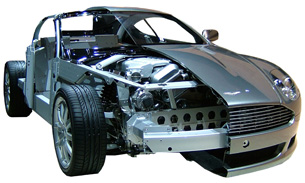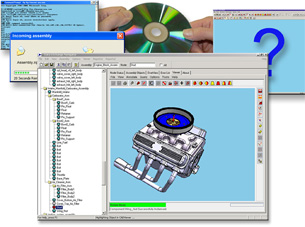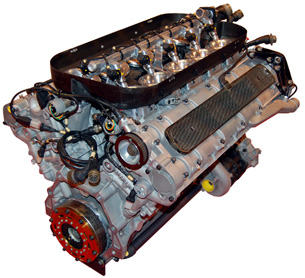10 Tips for Smooth MCAD Data Exchange
Commonsense guidelines from Theorem Solutions to help project team members side-step common digital data-exchange problems.
Latest News
May 3, 2009
By John Wedrychowski
 It is not unusual to receive more data than is needed; and most major design projects incorporate CAD data from more than one CAD system. |
CAD data exchange, interoperability, or whatever it gets called next is not a straight-forward process, and as such, it is often fraught with frustration due to wasted time and effort when translations are not performed accurately. Here, we’ll take a look at the process and how users can side-step common problems.
Receiving data
Tip 1: Know what you expect to receive and check it when you get it.
If you’re going to have to import or translate “foreign” data, it helps to know what you are going to receive so you can plan and ensure that when it does arrive, you’ve got enough time and have the appropriate translation tools for the job.
When you get it, can you view it? Can you see if it is an assembly rather than a single part? Does it contain colors and other attribute data you might need? How large are the files? Have you worked with data from this person and this source before? Does it look like business as usual or is this something new?
Tip 2: Understand what you have received.
Simple things often get overlooked. For example, make sure that you have checked the file extension and that zipped data has been unzipped. Then ask yourself, is it the right file type? Is it a compressed file? Is it a native CAD file or a STEP file? Don’t risk the embarrassment of calling a help desk to say that a translator doesn’t work when it is designed to translate a STEP file and you’ve been feeding it a native CAD file. It’s a good idea to define the process and work in the same way every time data is exchanged.
Tip 3: Treat incoming data with care.
Because nearly all data that is shared between two companies who are collaborating contains intellectual property (IP) of one or both companies, it should be treated with care. Electronic files should be stored in secure areas and not left attached to a memo in an e-mail inbox or in a directory on a public FTP site.
Ideally there should be a process that receives the data and before any validation, records what has arrived, puts the data in a secure place, and tells the sender that it has been safely received. A similar process should be in place for data that is received on physical media such as tape or disk.
 Theorem’s Data Exchange Navigator allows you to view and select just the parts or subassemblies needed. |
Tip 4: Only translate what you need.
It is not unusual to receive more data than is needed. Receiving a big CAD file that is not directly compatible with your own CAD system is not good. If you receive such a file you could ask the sender to provide you with only the data that you need.
If you can’t do that you may find that you can selectively translate just the geometry you need. It may be, for example, that a layering convention was used so you can translate just the layers that you want. It may be that the geometry you want is surface geometry, and your solution might be to translate just the surfaces.
Another alternative is to view parts or assemblies before translation. For example, Theorem’s Data Exchange Navigator enables you to view and select just the parts or sub-assemblies needed.
Tip 5: Determine when you’ve been successful.
Once translated, validate the file you have created. You might have a perfectly sound model, but it may not be the same as the original. Sometimes visual inspection of the source model and just making a visual comparison with the destination model is sufficient to see a problem; however, not seeing a difference does not mean that one doesn’t exist.
Validation of single translations is essential and it is even more important in migration projects where tens of thousands of files may be translated. Since manual checking of migrations costs too much, automated procedures need to be in place.
Tip 6: If you do not achieve success, go to Plan B and test paths.
If the translation fails, the first thing to do is to put a known test file through the translator—one that you would normally expect to translate successfully. If it fails, then check things like paths and licenses and permissions.
If the test file goes through OK, the problem probably lies with the incoming file. Your first decision is whether to try to resolve this yourself or to pass it back to the sender. If you decide to resolve the issue first, display the source data to see if it looks wholesome. Gaps between surfaces or missing surfaces may be obvious and could indicate a bad file. Also, check the file size and ask the person who sent it to confirm what size it should be—the process of copying it or moving it might have caused a problem.
Another option is to try to translate the file into a different format. If you have more than one translator, you might find that a troublesome file will go into a different format without a problem. If you have the correct tools, the only thing that should prevent you from creating a file in the format you desire is a fault in the source file. If that is the case, you have little option other than going back to the person who sent the original file.
 Data that is shared between two companies for collaborative work contains intellectual property of one or both companies. |
Sending data
Tip 7: Send only high-quality data.
If you want your business partners to successfully import the files you send them, make sure you send the best quality files. Run them through whatever “checking” routine there is in your design software. If there are errors—even if they don’t make any difference in your own CAD package—they might be showstoppers in translation.
If your CAD package creates solids even if there are gaps in the surfaces, there is no guarantee that a translated part will be read into another package and represent the data as solid. If solids are important, send solids, not surfaces with gaps.
Tip 8: Know what the data will be used for and send lightweight data if possible.
If you know that the end objective can be achieved by sending lightweight data, then that is the best method to use. Creation of lightweight data is quick, results in small files, and rarely fails to be read into the destination CAD system.
If the data is going to be used for packaging, rapid prototyping, including the use of stereolithography, or approximate clash detection, just send tessellated data. However, lightweight formats can include accurate B-rep geometry and can, therefore, be used for almost anything that could have been achieved with the original CAD file. If accuracy is important or if the data might be used for manufacturing, create and send lightweight B-rep.
Interoperability via a lightweight data format is one of the best ways of limiting the transfer of IP to the outside world. It could, therefore, be argued to be technically sufficient and commercially ideal.
Tip 9: If possible, send only the data that the recipient needs.
Know precisely the data your recipient needs and send just that–in whatever format is best. It is good practice, where possible, to send only what your supplier needs and nothing more.
Tip 10: Determine if the data should include features and history.
If the recipient of your translated data needs features and history, experience shows that your chances of success are not as good as they would be with explicit translation. In addition, sending models with features and history can send confidential information and IP. The trade-off is that it should provide the recipient with a fully modifiable data set. Keep in mind, this is often governed by company IP policy.
These procedural tips should go a long way to assure smooth sailing in data exchange.
More Info:
Theorem Solutions
Loveland, OH
John Wedrychowski is the marketing manager for Theorem Solutions. You can comment on this article via e-mail sent to [email protected].
Subscribe to our FREE magazine, FREE email newsletters or both!
Latest News
About the Author
DE’s editors contribute news and new product announcements to Digital Engineering.
Press releases may be sent to them via [email protected].






